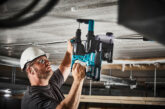
While 2020 presented the social housing industry with some of its toughest challenges to date, particularly in relation to COVID-19, it also offered significant opportunities for evaluation and improvement, particularly with regard to how fire safety systems are implemented, managed and maintained throughout a building.
James King, FireAngel’s Connected Home Director, discusses the important role digital technologies will play in realising these opportunities with Dan Daly, National Fire Chiefs Council (NFCC) Lead and former Assistant Commissioner for Fire Safety for the London Fire Brigade.
No doubt, these technologies will also increase tenant engagement by providing people with the ability to access and understand information regarding their building, James and Dan discuss:
James King: The National Fire Chiefs Council (NFCC) is working with every Fire and Rescue Service (FRS) in the UK to drive changes that will stop an event such as the Grenfell Tower fire from ever happening again. How is the NFCC working to change the way that buildings – including high-rise homes – are constructed, refurbished and managed?

Dan Daly: In the immediate aftermath of the Grenfell Tower fire, the NFCC worked alongside Government and other partners, carrying out some initial reviews of high-rise residential buildings where concerns existed about their external wall systems. This has led to a more comprehensive review of all high-rise residential buildings in a Building Risk Review process that will complete at the end of 2021, with NFCC coordinating and supporting Fire and Rescue Services across the country.

NFCC fed into the Dame Judith Hackitt review of the building safety regime, providing the knowledge and experience of all services in carrying out their regulatory role to help inform the necessary improvements required right across that regime. NFCC are playing a continuing role in the workstreams that are now in place to deliver the recommendations coming from that review. Allied to this work has been the development of the Fire Safety Bill, the Building Safety Bill and the associated guidance. The Fire Safety Bill seeks to clarify the scope and application of the Fire Safety Order. The Building Safety Bill will enable some of the recommendations from the Dame Judith Hackitt review and the Grenfell Tower Inquiry, but also provide transparent accountability for safety throughout the life cycle of a building.
NFCC have throughout been represented on the Government’s Independent Expert Panel and now chair the Fire Protection Board, looking not only at high rise buildings, but also developing advice to support the remediation of buildings with unsafe cladding systems and a mandate to look at other higher risk property types.
A major challenge post Grenfell has been the availability and reliability of information about the built environment. Whilst this has improved, there is still some way to go to ensure that if in the future there is a need to review large swathes of the current building stock, there is access to accurate information about the occupancy of buildings, the materials used in their construction, the safety systems in place and how they are being maintained and so on, to inform necessary interventions and actions. This is why Dame Judith’s recommendations for a Golden Thread of information are so important.
James King: The Draft Building Safety Bill was released earlier this year, following on from the recommendations outlined within the Hackitt Report. What opportunities and challenges does the NFCC feel the provisions in the Bill present?
Dan Daly: The draft Bill is a really important milestone towards change, with much to be welcomed. However, it is the case that a lot of the detail for the secondary legislation is yet to be seen, and there are some areas where we think the Bill should go further.
We believe the scope of the Gateways regime for new builds could reasonably be wider from the outset. The Impact Assessment identifies the Bill will capture around 400 new high-rise residential buildings per year. This is a small number proportionately, and we would like to see consideration given to including more premise types where vulnerable people reside, from day one.
To create the right incentives in the system, the ability for clients to choose their own regulator should also be removed for all buildings, not just a subset. In that regard, we have welcomed the recent report of the Housing, Communities, and Local Government Select Committee following their pre-legislative scrutiny.
In terms of new and emerging technologies, having better information about construction products, along with test and performance data, is going to be key to support regulation of fire safety. The Bill would benefit from further clarification to improve confidence in the product testing regime, to ensure that safe products are being used.
The regulation of construction products should also look to better scrutinise Modern Methods of Construction (MMC), an area where an understanding of materials and construction technique performance is vital for those specifying their use. Consistency in this area would better enable building control bodies to focus on checking that products that have been approved are being installed correctly. A shared platform will be essential for all regulators in the area to share data, and report deficiencies or instances of materials and products being used incorrectly or beyond their tested limits.
NFCC’s submission on the draft Bill is available here.
James King: To successfully achieve this, how important do you think the transition from a paper-based approach, to a digitalised methodology that utilises Connected systems to support remote monitoring, will be?
Dan Daly: From a firefighting perspective, it’s imperative that we understand what the risk posed by any situation really looks like – and digital technologies can provide an understanding in real time of where people are within a building, what support may be required in the event of an emergency, what risk the building may present due to ongoing maintenance or failures in mechanisms to support firefighting and what actions must be taken to mitigate against those risks. The real time availability of this information is crucial, particularly with regard to time critical stages of an emergency, but also to inform preplanning and general awareness for fire crews.
In Protection and Prevention terms, the successful implementation of technologies that support the capture and evaluation of relevant building information will provide an approach that is extremely efficient, especially when compared to traditional paper-based methods. It will help fire and rescue services target our prevention activities, such as home fire safety checks, at the most vulnerable in our communities, informing our risk based inspection programmes for protection activities and alerting us to changed circumstances in the occupancy or condition of the building to update what we know.
There is a real opportunity at relatively low cost to install fire suppressions systems, common fire alarms and monitoring systems during the build phase of buildings to improve their accessibility and suitability for all residents, regardless of vulnerabilities to future proof the building for changes over time. This would equally give developers the opportunity to market their properties using safety and accessibility as significant benefits. However, the challenge is to ensure we don’t forget about the existing housing stock and work with the responsible persons for those buildings to consider how these systems can be retrofitted to support improved safety, and for the sector to continue to develop less intrusive and cost effective ways this can be introduced.
James King: In response to the recent release of the Charter for Social Housing Residents Social Housing White Paper, which aims to ensure greater landlord accountability and enhanced tenant safety, what opportunities do you feel the digitalisation of data presents for individuals residing within these buildings?
Dan Daly: NFCC welcomes the paper and in particular the strengthening of the ‘Resident’s Voice’. Public safety goes beyond being physically safe, it includes feeling safe and secure, and the paper aims to ensure it is easier for residents to raise concerns and are kept informed about safety where they live and understand their role in supporting their safety and the safety of their homes.
The consultation on smoke, carbon monoxide alarms and electrical safety is also welcomed, and we would support the intent to bring about the same legal responsibilities in social housing as those that exist for the private sector.
The proposals will have implications for landlords and building owners and challenges to meet the ask. These are not dissimilar to what we discussed earlier about building safety information and data and there is an opportunity here to consider how digital technologies can connect residents with information about where they live, intelligent systems that support life safety systems in buildings and information to responders so that the building safety requirements and the intent of this paper are met in a cohesive, joined up way.
James King: Finally, COVID-19 has had a significant impact on the sector throughout 2020. Can you please share your thoughts on how the industry has adapted to the challenges of the pandemic, particularly with regard to the inability to gain physical access to a property and the increased requirement for remote monitoring?
Dan Daly: The pandemic and the subsequent restrictions that were implemented to mitigate against the spread of the virus saw businesses and services quickly adapt their service delivery models so that they could continue to operate. That challenge was met at pace and has continued to evolve and improve over time and lessons have undoubtedly been learned about how we can operate differently and how we can be better prepared to respond in the future.
Fire Services have adapted the way we conduct our prevention and protection activities, working with partners to continue to support our most vulnerable and target those premises that present the highest risk through virtual delivery and desktop approaches amongst other activities.
Connected technologies have and continue to play an essential role in how businesses have adapted, presenting an intelligence-led way for service delivery by using remote monitoring of residents, systems and facilities to reduce physical checks and only responding to issues that are identified.
It’s important that we evolve to the challenges presented this year and that we take the opportunity to evaluate what worked well, not only so we are better placed to meet this sort of challenge in the future but also to improve the reach and coverage of vital services to vulnerable persons and targeting of risk for essential services.
For more information on how FireAngel can tailor a connected fire and CO safety solution for your housing portfolio, please visit the FireAngel website or contact your local specification manager.
The NFCC is the professional voice of the UK fire and rescue service. NFCC drives improvement and development throughout the UK FRS, while supporting strong leadership – including for the devolved administrations. NFCC delivers an approach where everyone works together and offers up sector-led solutions. To find out more visit the NFCC website.
Offering the ability to be upgraded and adapted at any time, FireAngel Connected utilises FireAngel’s patented Predict™ technology and Artificial Intelligence to facilitate remote real time monitoring of every alarm in each property. This supports automatic stratification of risk across an entire housing stock, saving providers valuable time and money, whilst also ensuring compliance with current and future legislation to deliver residents with the highest levels of fire and CO protection.








